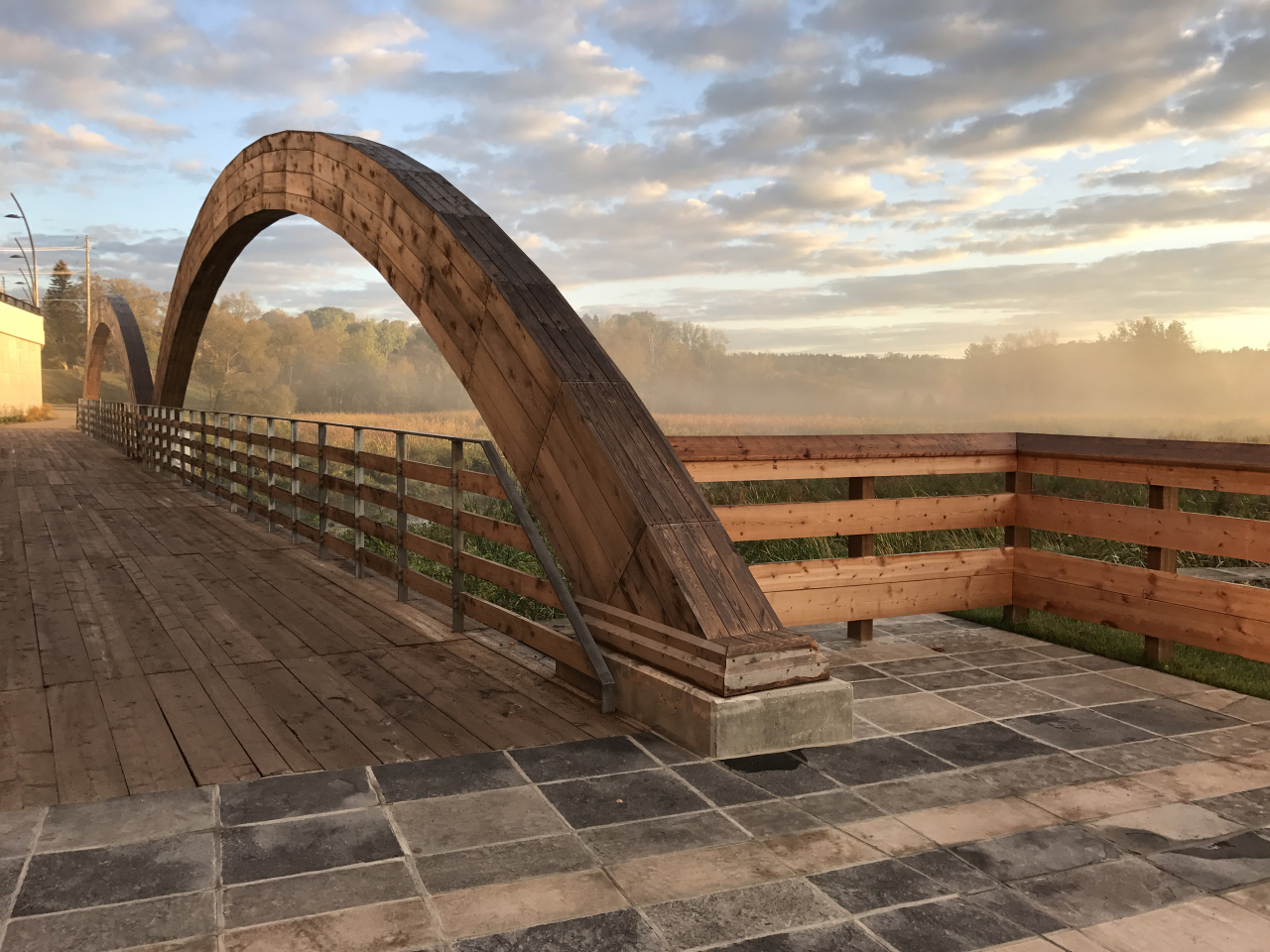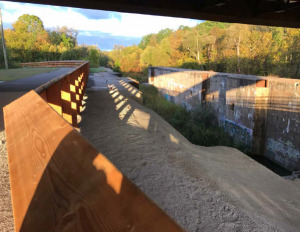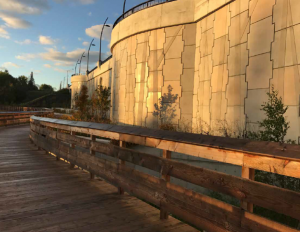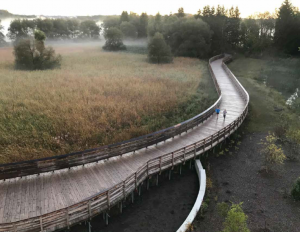 The 2nd Concession is a major north-south arterial corridor under the jurisdiction of the Regional Municipality of York (York Region). Located in the Town of East Gwillimbury, this is the second project in Ontario to earn an Envision award for sustainability from the Institute for Sustainable Infrastructure (ISI) and the first project in the transportation sector in the province to do so.
The 2nd Concession is a major north-south arterial corridor under the jurisdiction of the Regional Municipality of York (York Region). Located in the Town of East Gwillimbury, this is the second project in Ontario to earn an Envision award for sustainability from the Institute for Sustainable Infrastructure (ISI) and the first project in the transportation sector in the province to do so.
ABOUT THE PROJECT
The 2nd Concession project—the largest project ever undertaken by York Region’s Transportation Services Department—was a necessary investment in infrastructure to accommodate the tremendous growth in York Region and the Town of East Gwillimbury in particular. The six-kilometer corridor, extending from Bristol Road to Queensville Sideroad, crosses the Rogers Reservoir, a popular conservation area and recreational trail in the East Holland River watershed, which the Lake Simcoe Region Conservation Authority manages.
This project widened the 2nd Concession from two lanes to four and included trails, three bridges, retaining walls, active transportation facilities, and stormwater management.
Some of the unique elements of this project included:
—An elevated wooden boardwalk through wetlands and marshes connecting forests with growing residential communities.
—Benches, bike racks, and a flagstone meeting area.
—A wooden-clad pedestrian bridge in the Rogers Reservoir overlooks the historic canal and lock system, which the project protected and preserved.
—Bridges spanning an active rail corridor and the Holland River.
—Curvilinear and terraced tree-patterned retaining walls.
—Dedicated cycle tracks (the first in the Region).
ABOUT ENVISION® AWARDS FOR SUSTAINABLE INFRASTRUCTURE
The 2nd Concession project is the latest recipient of the Envision Bronze award. Envision is a holistic sustainability framework and rating system that enables a thorough examination of the sustainability and resiliency of all types of infrastructure. Envision includes 64 sustainability and resiliency indicators – called credits – divided across five categories (and 14 subcategories), including Quality of Life (well-being, mobility, community); Leadership (collaboration, planning, economy); Resource Allocation (materials, energy, water); Natural World (siting, conservation, ecology); and Climate and Resilience (emissions, resilience). The Envision Bronze award was granted to this project following ISI’s independent, third-party project review process – a transparent process to confirm that a project meets the sustainability criteria in the Envision framework.
“Congratulations to York Region and its project partners on earning an Envision Bronze award for sustainable infrastructure for the 2nd Concession project. This award results from tremendous teamwork, leadership, and community collaboration. Everyone in the area should be proud of this achievement. Protecting and enhancing the corridor area as an important resource for residents was given high priority in the planning and construction of the project, with a context-sensitive design maintaining or improving the natural systems and community quality of life aspects receiving careful attention.”
— Melissa Peneycad, ISI’s managing director
“Congratulations on the pace and quality of work that we are seeing on the bridge, pedestrian walkways and reservoir features. We are thrilled with the potential for this conservation area to be enjoyed by many who will no doubt want to visit here to experience the remarkable transformation that your team is delivering.”
N.M., a long-time resident living in the project corridor
“Yesterday was the first time we took our dogs for a walk along 2nd Concession. The view from the bridge is amazing. The viewing platforms on the bridge are a nice touch. The boardwalk for the trail blends in well with the environment. You and your staff have done a wonderful job on this project.”
— R.W. a long-time resident living in the project corridor
VERIFIED SUSTAINABILITY ACHIEVEMENTS
Meaningful community engagement.
The size and location of this project could have resulted in significant community opposition. Instead, early, consistent, sustained, and transparent community engagement built trust with residents and other local stakeholders and resulted in broad project support.
The community engagement process also resulted in other project benefits, such as accelerated timelines and saved tax dollars. Also, resident input led to several improvements to the project, including modifying the vertical profile of the corridor to eliminate steep grades, improve sight visibility, and enhance the safety of the Holland River Trail and Nokiidaa Trail, which cross the 2nd Concession. Specific resident concerns were also addressed, including driveway and tree planting modifications and improving the road surface during construction to create a better driving experience.
When it came time to open the project officially, approximately 1,000 residents attended the “Re-Opening Street Festival” and the official ribbon-cutting ceremony, a powerful testament to the project team’s efforts to engage stakeholders, including the public.
Improved infrastructure integration.
The 2nd Concession project integrated planning and design amongst various social, economic, and natural systems, improving infrastructure efficiency and effectiveness.
Many examples illustrate how this project improved infrastructure integration, including:
—Extensive coordination occurred with other works, including gravity and forcemain sanitary sewers, a watermain, two sanitary pumping stations with infrastructure connections to the corridor, a Paramedic Response Station, a public school, and adjacent land development activities.
—Improvements to the vehicular capacity to address anticipated traffic volumes to 2031 increase local community attractiveness to residents and decreases future economic costs from traffic congestion.
—The road was designed to avoid negatively impacting two watercourses. The project incorporated a wetland that benefits habitats and adds water quality and water quantity benefits for stormwater runoff while improving community attractiveness for residents and trail users.
—A new grade-separated crossing for the rail line improves rail operations and prevents traffic delays while enhancing safety for drivers, cyclists, and pedestrians.
—The new retaining wall for the road is both functional and aesthetically pleasing – it incorporates tree patterns that improve community attractiveness for residents and trail users.
—The bridge at the Holland River was raised, so it no longer rested on the historic lock system. Raising the bridge improved road grades for safety, the trail user experience, aesthetic views, and animal passage along the river (under the 2nd Concession).
Improved safety, mobility, and access. Many aspects of this project led to improvements in safety, mobility, and access. For example, the project improves connections to the Nokiidaa Trail at Rogers Reservoir. Wooden boardwalks and stepped planting beds over the rail line and Holland River, with lookouts to the east of the reservoir, elevate the user experience and enhance this important conservation area.
Meanwhile, traffic flow and safety improved by widening the 2nd Concession between Green Land and Doane Road and adding new streetlights along the corridor.
Cyclists were taken into consideration as well. The first in the Region, new dedicated cycle tracks were implemented as part of this project.
During the entire construction period, great care was taken to ensure the safe passage of pedestrians throughout the area. Maintaining access to local businesses was also a top priority throughout construction.
Wetland restoration. Part of this project involved the removal of 0.02 ha of degraded wetlands; however, 0.09 ha of wetlands were restored within the project boundary, resulting in a net increase in the wetland area, one that exceeds the Lake Simcoe Region Conservation Authority’s recommended 3:1 ratio. The wetland restoration plan included selecting a range of submerged, floating, emergent, shoreline and shrub wetland plant species to reflect the local native flora and site conditions. Rootwads, woody debris, and island features were provided for wildlife cover and basking opportunities.
Existing trees along the south side of the restoration were retained to provide a visual barrier to the rail line. The restored wetland, accessible by a trail, provides an added feature of interest for trail users to view, educational opportunities, and aesthetic benefits.
The wetland restoration efforts increased floodplain storage and enhanced the broader wetland’s floral and faunal habitat, resulting in an overall net improvement to the Rogers Reservoir.
PROJECT DETAILS AT-A-GLANCE
Envision-Verified Project: The 2nd Concession Project
Location: East Gwillimbury, Ontario, Canada
Envision Rating: Bronze
Owner: York Region
Project Delivery: Design-Bid-Build
Lead Envision Firm: York Region
Award Date: December 6, 2022
Project Phase: Operational
For More Information: View project brochure.
Download the Project Profile & Award Announcement.
ADDITIONAL PHOTOS






